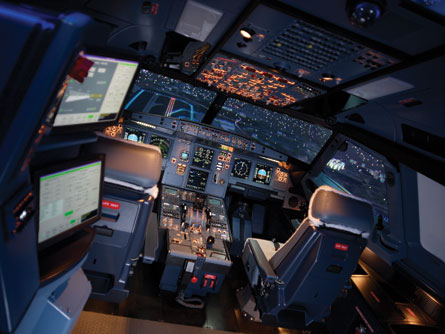It takes a particular kind of entrepreneurial skill, and grit, to compete against the two global beasts of simulation - particularly when your factory is practically in the shadow of one of them. That is what Montreal's Mechtronix has done since its origins in the late 1980s as an R&D project between a group of young university colleagues. The company went on in the 1990s to establish a niche in general aviation fixed-base simulators, before finally taking on its neighbour CAE and Europe's Thales in full-motion airliner simulators in the past 10 years.
"Twenty years ago, it was certainly not our intention to end up competing with CAE and Thales," admits chief executive and co-founder Fernando Petruzziello. "When we started we wanted to be leaders in fixed-base sims. But we found that revenue stream was limited. We were only ever going to get to a certain size. When the downturn came with 9/11 it gave us time to develop full-flight simulators." Today, says Petruzziello, the company has a 10-12% share of the markets in which it vies directly with its larger rivals.
Mechtronix - which is backed by investment firms La Caisse and Richardson Capital - focuses on Airbus and Boeing narrowbody simulators for "tier 2 and 3" airlines, and still has a foothold in general aviation types including Beechcraft and Cessna. About a third of its revenues come from outside aviation, mainly designing engineering equipment. The company is in the process of developing its first widebody simulator, for an Airbus A330. Over the past five years it has delivered four or five full-flight simulators. This year it will shift seven, says Petruzziello, and "we expect to maintain that rate going forward".
 |
|---|
©MechtronixA Mechtronix Airbus A320 simulator: the company has focused on second-tier airlines |
The emphasis on smaller, emerging airlines has stood Mechtronix in good stead. It is these carriers, often from developing economies and without a long-standing relationship with CAE and Thales, that have driven much of the demand for pilot training in the past decade.
However, Petruzziello has not given up on breaking into the established airline sector. "We are fostering relationships with a very select few tier-one carriers and we would hope to penetrate that market in two or three years," he says.
One important development for Mechtronix was the creation four years ago of its stand-alone services business ETOPS, headquartered in Toulouse, France. "We realised we were selling devices to airlines who perhaps did not have the expertise to set up the infrastructure," says Petruzziello. ETOPS can take charge of setting up the training operation, handling everything from the installation of the simulator to training the instructors, although Petruzziello insists that Mechtronix, with its around 200 employees, has no intention of training actual line pilots, as CAE does.
As for the future, investor Richardson Capital, which injected $35 million into the business three years ago, has set itself a five-year exit strategy. At that point, says Petruzziello, the company might seek another strategic partner or go public. With China, India and other rapidly developing markets desperate to develop pilots from their own domestic populations, demand for training devices is likely to continue ramping up - which is good news for Canada's other simulator manufacturer.
Source: Flight International























